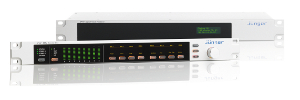Jünger Audio Introduces V*AP Voice Processor for VO Studios, Radio
The all-important human voice is getting some extra attention at the upcoming IBC 2012.
Next week, Germany-based dynamics processing specialist Jünger Audio is introducing V*AP, a brand-new two channel voice processor specifically designed for engineers working in radio stations and TV production voice-over (VO) studios.
Availability and pricing have not yet been announced. Here’s more details, straight from Jünger Audio:
“V*AP draws on Jünger Audio’s extensive experience with previous Voice Processing devices such as its v-series, but adds new tools and algorithms to create a new, easier and more efficient approach to voice processing with no compromise in sound quality.
V*AP’s main task is to offer perfect control of microphone recordings but Jünger Audio has also included processing such as HP/LP filtering, dynamic section, full parametric EQ and de-essing. All of the V*AP functions can be easily performed with the click of a mouse, making it hassle free for any journalist or reporter to use. Jünger Audio has also provided a dedicated voice leveler combined with a voice over circuit to help integrate voice programs into loudness-based broadcasting on the fly. Using the optional SDI I/O card automated voice over for embedded audio becomes an attractive feature of the V*AP.
Available as either an insert into a mixing desk or as a stand-alone unit, V*AP offers interfaces that allow integration in existing environments via an AES insert. The unit can also use used with an optional analogue board that adds two high quality mic-preamps.
Another key feature of V*AP is the inclusion of Spectral Signature, Jünger Audio’s automatic spectral sound management algorithm that dynamically boosts and attenuates frequency bands to preserve natural balance while achieving station sound without wide band crushing tools. With Spectral Signature, users can automatically analyze the ideal recording of their voice (direct or over telephone lines) and easily create pre-defined sound fingerprints that become the reference the algorithm matches to on all subsequent live recordings.”
Please note: When you buy products through links on this page, we may earn an affiliate commission.







